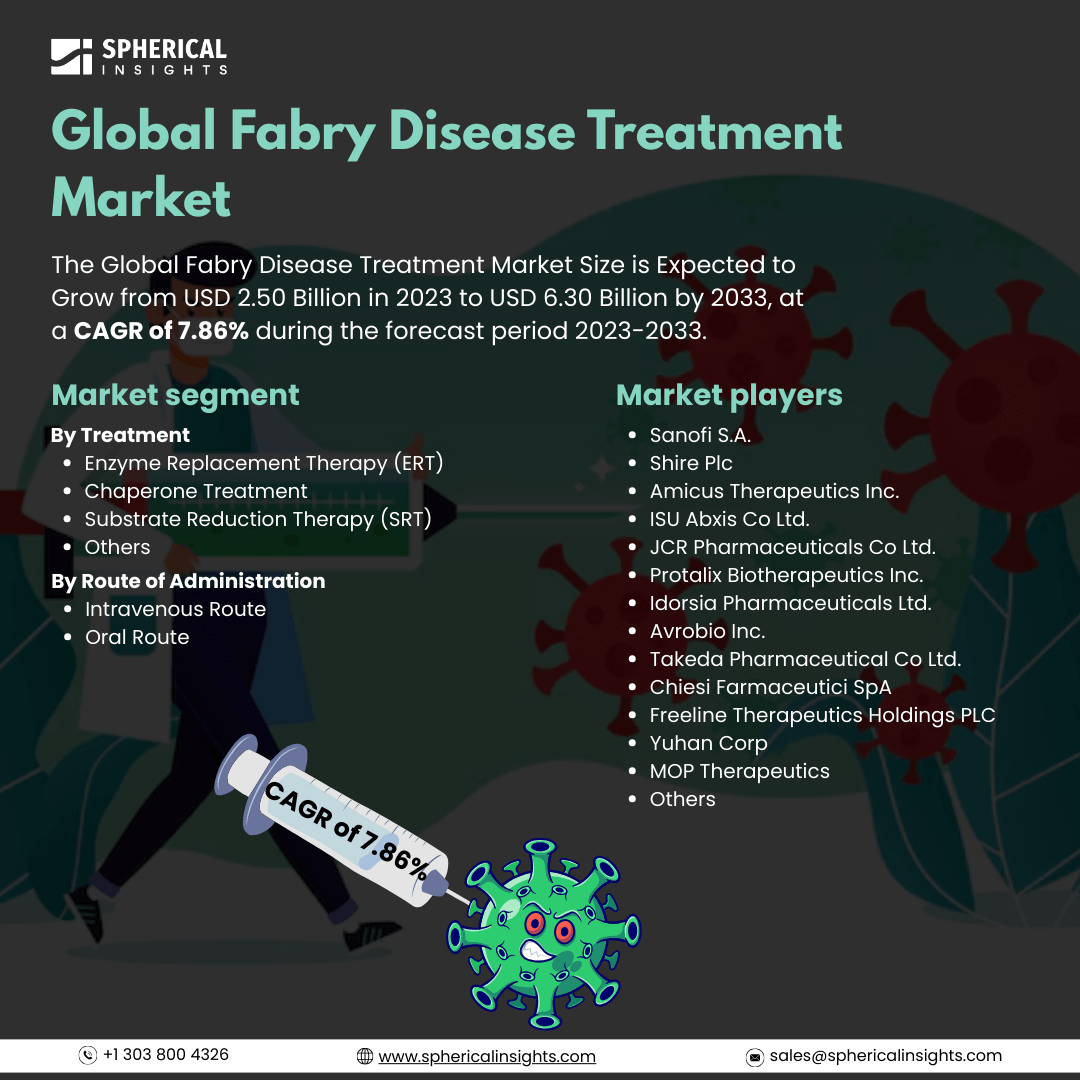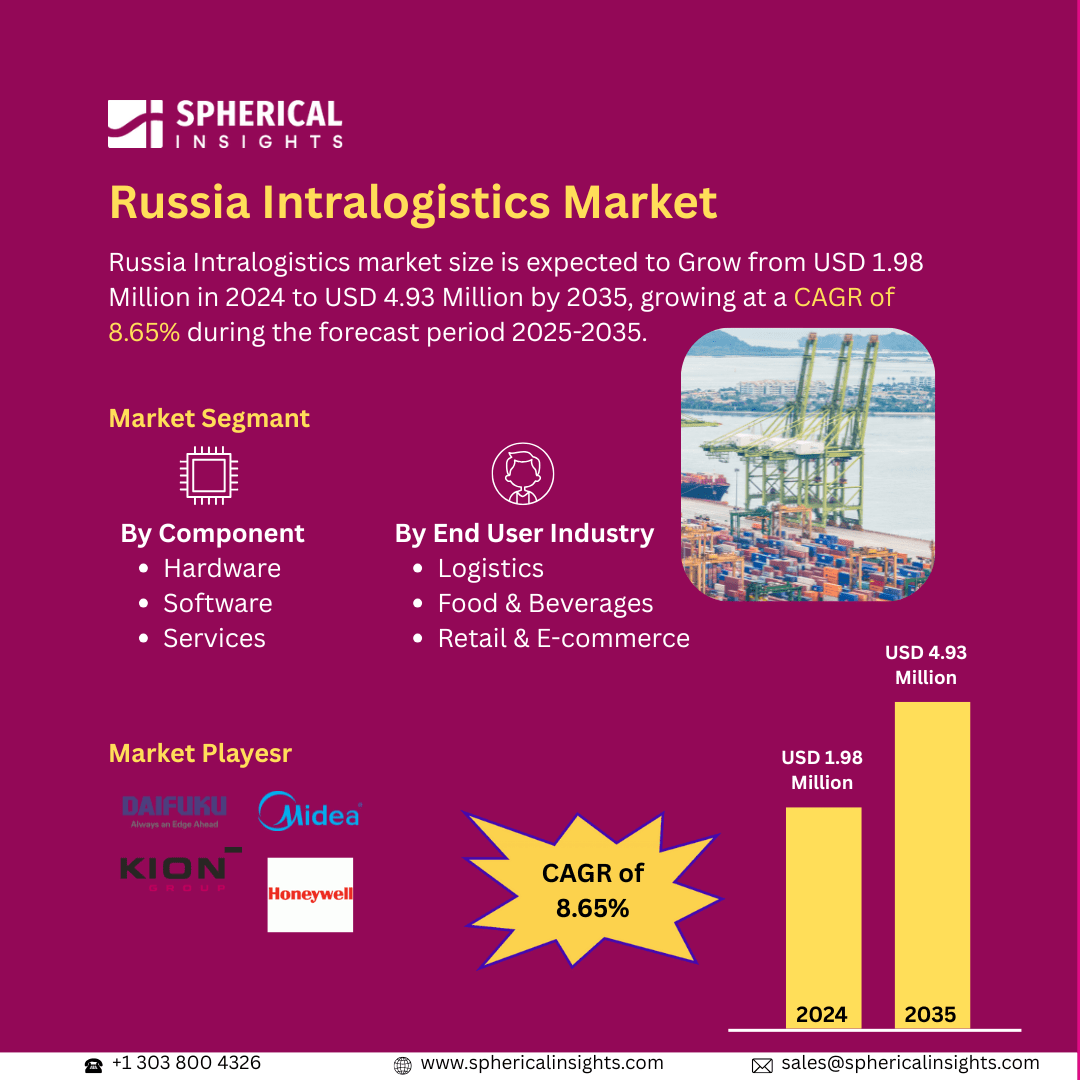Global Fabry Disease Treatment Market Size to Exceed USD 6.30 Billion by 2033
According to a research report published by Spherical Insights & Consulting, the Global Fabry Disease Treatment Market Size is Expected to Grow from USD 2.50 Billion in 2023 to USD 6.30 Billion by 2033, at a CAGR of 7.86% during the forecast period 2023-2033.
Browse 210 market data Tables and 45 Figures spread through 190 Pages and in-depth TOC on the Global Fabry Disease Treatment Market Size, Share, and COVID-19 Impact Analysis, By Treatment (Enzyme Replacement Therapy (ERT), Chaperone Treatment, Substrate Reduction Therapy (SRT), and Others), By Route of Administration (Intravenous Route and Oral Route), By Distribution Channel (Hospital Pharmacy, Retail Pharmacy, and Online Pharmacy), and By Region (North America, Europe, Asia-Pacific, Latin America, Middle East, and Africa), Analysis and Forecast 2023 – 2033.
The Fabry disease treatment market is the worldwide market engaged in developing, manufacturing, and marketing therapies for Fabry disease, a genetic disease with low incidence caused by an insufficiency of the alpha-galactosidase A (GLA) enzyme. The market covers enzyme replacement therapies (ERTs), chaperone therapies, gene therapies, and supportive treatments used to manage symptoms, delay the progression of disease, and enhance patient outcomes. It is spurred by increasing disease awareness, advances in biotechnology, rising healthcare expenditures, and approvals of novel therapies by regulatory authorities. Furthermore, the market for Fabry disease treatment is driven by increasing disease prevalence, growing awareness, and technological advancements in enzyme replacement and gene therapies. Increased R&D spending, government initiatives, and enhanced diagnostic technology further accelerate market growth. Moreover, the launch of new treatment products and the growth of healthcare infrastructure further improve patient access, driving market growth throughout the forecast period. However, the high treatment costs, limited patient awareness, delayed diagnosis, lack of curative therapies, stringent regulatory approvals, and restricted access to advanced treatments in developing regions are key restraints for the growth of the market.
The enzyme replacement therapy (ERT) segment accounted for the largest share in 2023 and is anticipated to grow at a significant CAGR during the forecast period.
On the basis of the treatment, the global Fabry disease treatment market is divided into enzyme replacement therapy (ERT), chaperone treatment, substrate reduction therapy (SRT), and others. Among these, the enzyme replacement therapy (ERT) segment accounted for the largest share in 2023 and is anticipated to grow at a significant CAGR during the forecast period. The segmental growth is attributed to its effectiveness in managing Fabry disease by addressing enzyme deficiencies. Growing patient adoption, ongoing clinical advancements, and regulatory approvals drive its significant CAGR growth. Increased healthcare investments and rising awareness further support the expansion of ERT as the preferred treatment option.
The intravenous route segment accounted for the largest share in 2023 and is anticipated to grow at a remarkable CAGR during the forecast period.
On the basis of the route of administration, the global Fabry disease treatment market is divided into intravenous route and oral route. Among these, the intravenous route segment accounted for the largest share in 2023 and is anticipated to grow at a remarkable CAGR during the forecast period. The segmental growth is attributed to its high efficacy in delivering enzyme replacement therapy (ERT) for Fabry disease. Growing adoption of intravenous treatments, improved infusion technologies, and increasing patient preference for hospital-based care drive its remarkable CAGR growth. Advancements in drug formulations further support segment expansion.
The hospital pharmacy segment accounted for the greatest share in 2023 and is anticipated to grow at a substantial CAGR over the forecast period.
On the basis of the distribution channel, the global Fabry disease treatment market is divided into hospital pharmacy, retail pharmacy, and online pharmacy. Among these, the hospital pharmacy segment accounted for the greatest share in 2023 and is anticipated to grow at a substantial CAGR over the forecast period. The segmental growth is attributed to the rising administration of Fabry disease treatments, particularly enzyme replacement therapy (ERT), in hospitals. Increasing hospital visits, availability of specialized care, and strong supply chain networks drive its substantial CAGR growth. Enhanced regulatory compliance and expanding healthcare infrastructure further support market expansion.
North America is projected to hold the largest share of the global Fabry disease treatment market over the forecast period.
North America is projected to hold the largest share of the global Fabry disease treatment market over the forecast period. North America's dominance in the Fabry disease treatment market is driven by advanced healthcare infrastructure, high awareness, and strong regulatory support. The presence of key pharmaceutical players, increasing adoption of enzyme replacement therapy (ERT), and rising healthcare investments further contribute to market growth. Additionally, favorable reimbursement policies and extensive research initiatives enhance treatment accessibility and innovation.
Asia Pacific is expected to grow at the fastest CAGR growth of the global Fabry disease treatment market during the forecast period. The regional growth is attributed to the rising Fabry disease awareness, improving healthcare infrastructure, and increasing government initiatives. Expanding access to advanced treatments, growing investments in rare disease research, and the presence of emerging pharmaceutical companies further fuel market expansion. Additionally, a large patient population and improving diagnostic capabilities drive demand for effective therapies.
Company profiling
Major vendors in the global Fabry disease treatment market are Sanofi S.A., Shire PIc., Amicus Therapeutics Inc., ISU Abxis Co Ltd., JCR Pharmaceuticals Co Ltd., Protalix Biotherapeutics Inc., Idorsia Pharmaceuticals Ltd., Avrobio Inc., Takeda Pharmkceutical Co Ltd., Chiesi Farmaceutici SpA, Freeline Therapeutics Holdings PLC, Yuhan Corp, MOP Therapeutics, and others.
Key Target Audience
- Market Players
- Investors
- End-users
- Government Authorities
- Consulting and Research Firm
- Venture capitalists
- Value-Added Resellers (VARs)
Recent Development
- In May 2023, to treat Fabry disease, Sangamo Therapeutics, Inc., a genomic medicine company, received fast-track designation for isaralgagene civaparvovec, also known as ST-920, a gene therapy product candidate that it fully owns. Thus far, ST-920 has been administered to 20 patients in the Phase 1/2 STAAR study, which is currently assessing the medication.
Market Segment
This study forecasts revenue at global, regional, and country levels from 2023 to 2033. Spherical Insights has segmented the global Fabry disease treatment market based on the below-mentioned segments:
Global Fabry Disease Treatment Market, By Treatment
- Enzyme Replacement Therapy (ERT)
- Chaperone Treatment
- Substrate Reduction Therapy (SRT)
- Others
Global Fabry Disease Treatment Market, By Route of Administration
- Intravenous Route
- Oral Route
Global Fabry Disease Treatment Market, By Distribution Channel
- Hospital Pharmacy
- Retail Pharmacy
- Online Pharmacy
Global Fabry Disease Treatment Market, By Regional
- North America
- Europe
- Germany
- UK
- France
- Italy
- Spain
- Russia
- Rest of Europe
- Asia Pacific
- China
- Japan
- India
- South Korea
- Australia
- Rest of Asia Pacific
- South America
- Brazil
- Argentina
- Rest of South America
- Middle East & Africa
- UAE
- Saudi Arabia
- Qatar
- South Africa
- Rest of the Middle East & Africa



